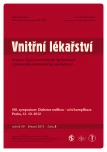Diabetic macular oedema in the third trimester of pregnancy
Authors:
J. Šimičák
Authors‘ workplace:
Oční klinika Lékařské fakulty UP a FN Olomouc, přednosta doc. MUDr. Jiří Řehák, CSc., FEBO
Published in:
Vnitř Lék 2013; 59(3): 227-230
Category:
Case Reports
Overview
The authors describe a case of a female patient with diabetes mellitus (DM) type 1 who faced a progress of diabetic retinopathy (DR) during her pregnancy with a development of diabetic macular oedema (DMO) and a deterioration of visual acuity (VA) in the right eye. The patient had been under observation for DM for 18 years, the last six years for the onset of the non-proliferative form of DR. During the 28th week of pregnancy, a significant reduction of visual acuity in the patient‘s right eye occurred as a result of a fast developing DMO. The patient was generally given corticosteroids for a gynaecological indication to accelerate the maturing of the foetus. Betamethasone (Diprophos) in dose 12mg with intramuscular application was administered twice in total, i.e. in the 29th and the 32nd week of pregnancy. After each application, a good effect was observed on the improvement of the visual acuity accompanied by a DMO reduction. However, the effect of corticosteroids was only temporary and at the end of their application in each case, a fast reduction of VA and a progression of DMO were observed, even though retinal laser photocoagulation was initiated. Delivery via Caesarean section was indicated in the 35th week of pregnancy, after a consultation with a diabetologist, gynaecologist and ophthalmologist. The delivery went without complications; both the child and the mother were in a normal condition after the delivery. A gradual improvement in VA was observed during the post-delivery period, with a reduction of DMO until a level of VA that corresponded to the status before the pregnancy was reached.
Key words:
diabetic macular oedema – corticosteroids – laser retinal photocoagulation
Sources
1. Miracle X et al. Guideline for the use of antenatal corticosteroids for fetal maturation. J Perinat Med 2008; 36: 191–196.
2. Kuchynka P et al. Oční lékařství. Praha: Grada Publishing 2007: 300–301.
3. Early Treatment Diabetic Study Research Group. Treatment techniques and clinical guidelines for photocoagulation of diabetic macular edema. Ophthalmol Report No. 2 1987; 94: 761–774.
4. Chrapek O, Jirková B, Šín M. Léčba diabetické retinopatie. Postgrad Med 2012; 14: 668–675.
5. Nguyen QD, Shah SM, Khwaja AA et al. Two-year outcomes of the Ranibizumab for Edema of the mAcula in Diabetes (READ-2) study. Ophthalmology 2010; 117: 2146–2151.
6. Mitchell P, Bandello F, Schmidt-Erfurth U et al. The RESTORE study: ranibizumab monotherapy or combined with laser versus laser monotherapy for diabetic macular edema. Ophthalmology 2011; 118: 615–625.
7. Chrapek O, Jirková B. Zásady a rizika intravitreální aplikace anti-VEGF preparátů. Remedia 2008; 18: 389–394.
8. Grigorian R, Bhagat N, Lanztta P et al. Pars plana vitrectomy for refractory diabetic macular edema. Semin Ophthalmol 2003; 18: 116–120.
9. Bandello F, Cunha-Vaz J, Chong NV et al. New approaches for the treatment of diabetic macular oedema: recommendations by an expert panel. Eye 2012; 26: 485–493.
10. Sinclair SH, Nesler C, Foxman B et al., Macular edema and pregnancy in insulin-dependent diabetes. Am J Ophthalmol 1984; 97: 154–167.
11. Best RM, Chakravarthy. U Diabetic retinopathy in pregnancy. Br J Ophthalmol 1997; 81: 249–251.
12. Diabetic Retinopathy Clinical Research Network. The Relationship between OCT-Measured Central Thickness and Visual Acuity in Diabetic Macular Odema. Ophthalmol 2007; 114: 525–536.
Labels
Diabetology Endocrinology Internal medicineArticle was published in
Internal Medicine

2013 Issue 3
Most read in this issue
- Diabetic nephropathy/diabetic kidney disease
- Treatment of diabetic macular oedema
- Progression of diabetic retinopathy in pregnancy
- Patophysiology of diabetic retinopathy
